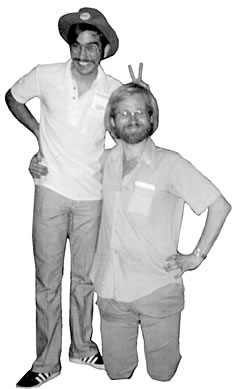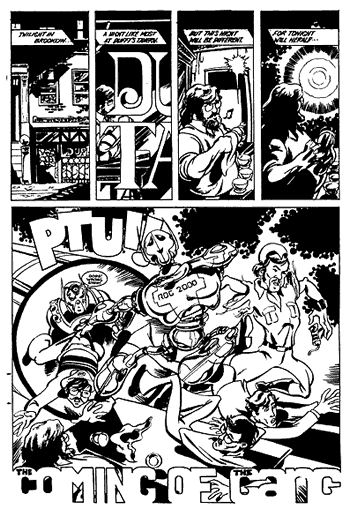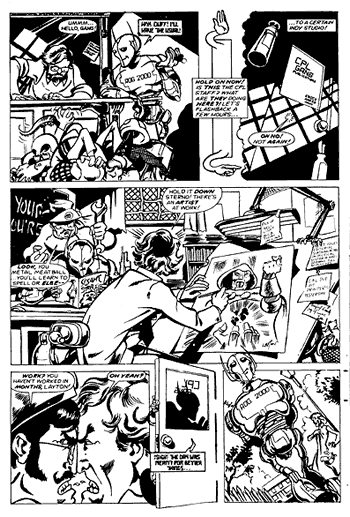Rog-2001: Sterno Speaks!
Writer Roger Stern on the CPL/Gang-Charlton Connection
Conducted by Jon B. Cooke
From Comic
Book Artist #12
An entertaining and eminently capable comics writer, Roger Stern
is perhaps best recalled for his work on the Superman strip in Action
Comics, Amazing Spider-Man, The Avengers, Dr. Strange, and an especially
memorable collaboration with John Byrne on Captain America in 1980-81.
What you may not know is Sterno's career stretches back to Charlton
(sorta) and the fanzines. The following E-mail interview took place
in January, 2001.
Comic Book Artist: When and where were you born?
Roger Stern: September 17, 1950 in Noblesville, Indiana, a
small town one county to the north of Indianapolis.
CBA: First memories of comics?
Roger: My earliest comics memory is of sitting on my Grandfather's
knee as he read me the Sunday comic strips. Mom and Dad read them
to me, too. I'd point to the individual panels, and the folks
would read me the dialogue. And as soon as I was able to read for
myself, I was allowed to plunk down my dimes for comic books at Hudson's
Drugstore. I can't remember what the first one was... probably
an issue of Walt Disney's Comics & Stories. But Superman
followed pretty quickly—I already knew him from TV.
CBA: Did you develop aspirations to work in comics?
Roger: Oh, not until I was in my early twenties. I always loved
comics, but I never expected to make a living writing the crazy things.
After all, I lived out in the middle of Indiana. It wasn't until
after I started working on fanzines with Bob Layton, that I started
to get a feeling that maybe I would want to try and get a little freelance
work in the business. But I never imagined that it would wind up being
my day job for 25 years.
CBA: Recall your first memories of Charlton comics?
Roger: I remember it vividly. It was New Years Eve, 1959, and
I bought a copy of Space Adventures #33 at Hayden's Drugstore.
That issue had the origin and first appearance of Captain Atom. It
became one of those comics that I read until the cover separated and
fell apart. (Just for the record, there were only three comic books
that I ever read that heavily. The other two were The Double Life
of Private Strong #1 and The Brave and the Bold #28.) Looking back,
that must have been my first exposure to Steve Ditko's art—very
nice! It was so moody... I don't think I'd ever seen
anyone sweat in a comic book before that!
One of the things which impressed the nine-year-old me about that
story was that it guest-starred the actual President of the United
States! Steve Ditko drew a pretty
recognizable Dwight Eisenhower. The face was retouched in later reprintings,
but in the original comic it was definitely Ike's. Anyway, I
kept going back to the comics spinner, looking for more of this Captain
Atom guy, but didn't find any for years and years. Charlton's
distribution was always pretty spotty in central Indiana. I never
saw another Captain Atom issue until the Action Heroes revival in
the mid-sixties. It was about six years before I bought another Charlton
comic. But when I discovered Spider-Man, I suddenly realized, "Hey!
This is drawn by the same guy who drew Captain Atom!"
CBA: When did you first become involved in fandom?
Roger: That would have been in college. I'd been aware
of fandom since my early teens, but I never really got too heavily
into fanzines in my younger years. I never trusted the post office
when I was a kid—they kept losing the cereal boxtop premiums
I sent off for—or I might have tried subscribing to some of the
earlier fanzines. But when I was in college, I managed to receive
the issue of Alter Ego that Roy Thomas advertised in the Marvel books,
and from there I learned about the conventions Phil Seuling threw
in New York. With two college buddies, I drove to New York for the
1970 convention. And that lead to finding more 'zines, and meeting
more fans... I even found a few in Indiana.
CBA: When did you meet Bob Layton?
Roger: Oh, gee, that must have been sometime around 1973. Bob
was playing comics dealer at the time, selling them out of his apartment
in Indianapolis. By that time I was out of college and working in
Indy, and we were introduced by some other area fans.
CBA: Can you give us a history of CPL and your involvement?
Roger: Bob can tell you about its beginnings better than I.
But as I recall, CPL started out as Bob's sale catalog. Bob was
drawing the covers and including little reviews written by some of
his customers. By issue #5, it turned into a small 'zine with
a catalog insert, and I started
writing short articles for it. I eventually became an editor of sorts.
CBA: Was CPL successful and can you share anecdotes?
Roger: That depends upon how you define success. As I recall,
we maintained a fairly regular publishing schedule for nearly two
years... which was pretty unheard of for most 'zines in those
days. None of us made any money off of it, but we had a lot of fun.
I can still remember sitting on the floor of Bob's apartment,
collating pages and stapling them together. CPL was sort of a stepping
stone into the business for Bob, John Byrne, and me. None of that
was planned, of course. It just sort of happened.
CBA: How did you guys get Toth to do "The Question"
story?
Roger: Dumb luck, I guess. Somehow, we'd gotten Toth's
address and sent him a complimentary copy of CPL. Then, we managed
to get him to draw a cover for issue # 11. When Bob launched Charlton
Bullseye, one of the things we both really wanted to do was run a
new Question story—and since we weren't sure how to get
in touch with Steve Ditko, we hit on the idea of asking Toth. I think
Bob called him. Anyway, Toth said yes.
CBA: Did you produce stories directly for Charlton? If so,
what were they and how was it dealing with George Wildman and/or Nick
Cuti?
Roger: I wrote only three stories for Charlton, but none of
them were ever published. Two were Rog-2000 stories for the back of
E-Man. They were accepted on a Friday... and then E-Man was canceled
on the following Monday, so they were never officially bought. I think
I still have a copy of the scripts somewhere. My first real sale was
a book-length Phantom story which was actually bought and paid for...
but never drawn. I'd been corresponding with Don Newton, and
he'd encouraged me to submit ideas for The Phantom. I sent in
three or four plot ideas, and Charlton accepted the one that I thought
was the least original... all about the Phantom discovering a lost
Atlantean colony in a hidden corner of the Deep Woods. The real shame
was that Don was just bubbling over with great ideas for The Phantom—ideas
that the readers never got to see. He wanted to develop a regular
antagonist for the Phantom, a real opposite number that Don had tentatively
called the Red Spectre. As I recall, that particular idea was shot
down as being "too much like Marvel." Since Marvel was—at
the time—beating the pants off everyone in sales, I could never
figure out why Charlton was so reluctant. Maybe they were getting
flak from King Features. Like I said, it was a shame, because Don's
Phantom was so good, but it could have been really great. Anyway,
on the Rog-2000 stories, I worked with Nick Cuti, who was incredibly
nice about walking me through the process and helping me fix what
I was doing wrong. By the time The Phantom came along, Nick had gone
freelance, and the editor I worked with was Bill Pearson. I did meet
George Wildman briefly at a New York convention, but I never had any
formal contact with him as a writer.
CBA: Did you enjoy the '70s Charlton books?
Roger: Sure, though not as much as I liked the late '60s
Charltons. I especially loved Ditko's work on Captain Atom and
The Blue Beetle, but I followed their whole Action Hero line. There
was all of that great early work by Aparo, O'Neil, and Skeates...
Dick Giordano on Sarge Steel... P.A.M., Pat Boyette. Mighty nice.
I stuck with the Charlton Ghost books into the '70s, because
they were the only place you could find Ditko on a regular basis.
And then E-Man came along—sweet stuff.
CBA: Do you recall meeting John Byrne for the first time?
What was your relationship and did you collaborate early on material?
Roger: Yes, that would have been the July 4th weekend of 1974.
John and I had corresponded prior to that, and I think we might have
even chatted on the phone once or twice, but that was our first face-to-face
meeting. By that time, of course, we had already worked together on
the Rog-2000 strip which wound up appearing in CPL #11. Bob, John,
our pal Larry Brnicky, and I all converged on Duffy Vohland's
apartment in Brooklyn just prior to the '74 Seuling Con, and
that's where John and I met. (Anyone who had any drawing ability
wound up inking backgrounds on a George Perez story for Monsters Unleashed.)
The reason we were all in New York was that we were premiering a double-issue
of CPL—in the guise of the Charlton Portfolio—at the convention.
In fact, it was at that convention that Nick Cuti saw the art for
the first Rog-2000 strip. And that led to John's getting work
at Charlton, drawing Rog as a backup in E-Man. That led to Wheelie
and the Chopper Bunch, Doomsday +1, and Space: 1999... and, indirectly,
to "Iron Fist" at Marvel.
CBA: Were your aspirations to break into Marvel and/or DC?
How did the final break come about?
Roger: Oh, no. As I said earlier, I never expected to work
in comics. I went to work writing commercial copy for an Indianapolis
radio station in 1973—and, if I gave the future any thought at
all, I figured that I'd have a modest career in broadcasting.
As CPL became better known, I picked up a few freelance assignments
for Marvel's fanzine FOOM, and I started to give some thought
to writing the occasional story for Charlton on the side. Then, I
was fired from the radio station. (A newly-hired Station Manager had
a friend who was looking for work—and so, I was soon the one
who was looking for work.) That was late in the Summer of '75,
just before Bob Layton launched NAPCON, Indianapolis's first
comics convention. The plus side of getting fired meant that I had
more time to spend at the con. Not long afterward, Bob moved east
to Connecticut to pursue comics work, and I spent about four months
sending out resumes and collecting unemployment. Then, in December
of '75, I got an offer to test for an assistant editor job at
Marvel. I passed the test and wound up working full-time in comics
for the next 25 years.
CBA: Can you tell us of your involvement in the development
of Charlton Bullseye?
Roger: After the '74 New York convention, I went back
to Indiana. But Bob stayed over a few extra days, and went up to visit
the Derby offices. When he returned, he sat me down and told me that
Charlton had given him approval to produce Bullseye. And he wanted
me to write for it. Well, of course, I agreed. It sounded like great
fun, and I figured that I might even get an opportunity to learn more
about writing for comics. I had no idea that I was soon going to get
thrown into the deep end.
What happened was Charlton had an unpublished Captain Atom story
in the drawer, fully penciled by Steve Ditko, but there was no sign
of a plot or script. The original plan was for the story to be scripted
by Len Wein or Marv Wolfman—or both of them—and that Klaus
Janson was going to ink it. Somehow, that never happened. I wound
up scripting the story and Brother Byrne wound up inking it. I used
a pseudonym on the first part, because I was so spooked over the idea
of scripting a Steve Ditko story. His storytelling was so clear that
I had no trouble telling what was going on. I haven't looked
at the script in years. I'm almost afraid to. (That was the first
time John inked Steve Ditko; you might want to ask him about it.)
CBA: Was Bullseye successful?
Roger: Well, we had fun while it lasted. I didn't really
do as much work on Bullseye after Bob moved to Connecticut. He produced
the last two issues in Derby, and my only contributions were a short
essay about Charlton science-fiction comics and the plot idea for
the Question story—and I think that work was probably done before
Bob's move. But I had a lot of fun making up back-stories for
Dr. Graves and Mr. Dedd. I even got the opportunity to come up with
first names for them and Captain Adam.
CBA: Ideally, would you have wanted to revive the Action Hero
characters?
Roger: Oh, yeah. I loved those characters. I always thought
it was a shame that DC changed them so much from what they had been.
I never thought there was much wrong with the concepts or the characters.
What they mainly needed was better printing and production values—and
much better distribution!
CBA: Did you maintain contact with Bob Layton and John Byrne
after the end of CPL and Charlton Bullseye?
Roger: Oh, sure. Once I had landed at Marvel, it was actually
easier to stay in touch. John was already penciling Iron Fist, and
was visiting New York on a more regular basis. And I eventually became
his editor (on X-Men, Avengers, and Marvel Two-In-One) and Bob's
(on Iron Man). Of course, I worked with John as writer on Captain
America, we all worked on a Hulk Annual, and in the Fall of '99,
Bob penciled part of an Iron Man story that I wrote.
CBA: Can you describe your collaborations with John Byrne?
Roger: Big fun. We're on the phone a lot, just as a matter
of course. We probably make AT&T very happy. When we've worked
together, I've generally given John a fairly loose plot. In fact,
on the recent Marvel: The Lost Generation, we mostly just talked over
the general thrust of the stories before he went off and drew them.



